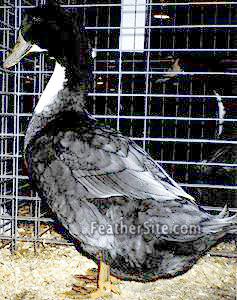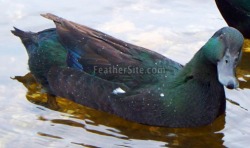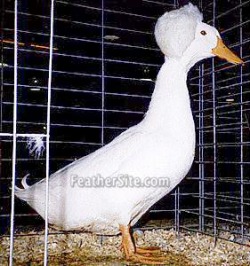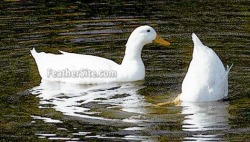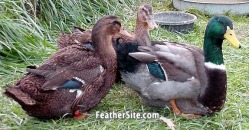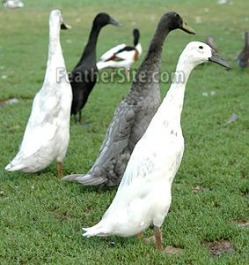T.C. Hatchery
Blue Swedish
~Current amount: None
These medium weight birds have white bibs and on good specimens the outer 2 primaries on the wings are also white. Like many fowl, they do not breed true in the Blue form, so that out of a breeding of 2 Blues you will get 50 percent Blue, 25 percent Black and 25 percent Silver or Splash.
These ducks are hardy and are good foragers.
These ducks are hardy and are good foragers.
Cayuga Ducks
~Current amount: None
This is one of the breeds of duck developed in North America. It is a hardy and quiet breed. These ducks are best known for their plumage, which is a brilliant greenish-black. They are quite amazing to see in the sunlight.
Early in the season, Cayuga eggs are usually black or dark gray, fading to light gray or blue over the laying season.
Early in the season, Cayuga eggs are usually black or dark gray, fading to light gray or blue over the laying season.
Crested Pekin
~Current amount: None
With the powder-puff of feathers on its head, the Crested Duck is truly striking. It is a medium-weight dual purpose breed. The ducklings grow fairly quickly, making them good birds for the table, and they are good layers.
An adult drake weighs about 7 pounds, and his mate about 6. The Standard of Perfection (USA) recognizes two forms: Black and White. Other varieties, such as Grey (Mallard coloration), Buff and Blue have been developed by breeders, and crests may appear on others. Crests should be large and sit symmetrically on the center of the head. The body should be carried nearly horizontally.
The crested gene in these ducks is linked to a lethal condition during incubation. Ducklings carrying both genes (homozygous) for the crest do not survive to hatch. Of those that do hatch, typically 1/3 of them will not have crests. It is easy for breeders to see how the crests will develop on the newly hatched duckling, so that they can select stock to raise and sell off the rest as day-olds, rather than having to feed them until they grow up.
An adult drake weighs about 7 pounds, and his mate about 6. The Standard of Perfection (USA) recognizes two forms: Black and White. Other varieties, such as Grey (Mallard coloration), Buff and Blue have been developed by breeders, and crests may appear on others. Crests should be large and sit symmetrically on the center of the head. The body should be carried nearly horizontally.
The crested gene in these ducks is linked to a lethal condition during incubation. Ducklings carrying both genes (homozygous) for the crest do not survive to hatch. Of those that do hatch, typically 1/3 of them will not have crests. It is easy for breeders to see how the crests will develop on the newly hatched duckling, so that they can select stock to raise and sell off the rest as day-olds, rather than having to feed them until they grow up.
Pekin
~Current amount: None
I have only one Pekin these days, a drake named "SquareHead," but I really like to explain to folks that Pekin ducks are the large white domestic duck that Donald was modeled after, and Peking duck is a dish (often containing a Pekin duck) on the menu in a Chinese restaurant.
Pekins were developed as a meat and egg breed, and broodiness was bred out of them so that they'd lay more. Therefore, if you have Pekin eggs, you'll need to incubate them artificially, as most Pekin ducks will never sit.
Pekins were developed as a meat and egg breed, and broodiness was bred out of them so that they'd lay more. Therefore, if you have Pekin eggs, you'll need to incubate them artificially, as most Pekin ducks will never sit.
Rouen Ducks
~Current amount: None
Rouen (pronounced roan) ducks are a large breed of duck with the same color pattern as the wild mallard.
Show-quality Rouens have a very large, almost dragging, keel: the flesh hanging under the breast and between the legs. You can see this on the drake above and the hen just below. The birds pictured lower on the page are farmyard Rouens. These are the birds you typically get when acquiring ducks from commercial hatcheries.
Show-quality Rouens have a very large, almost dragging, keel: the flesh hanging under the breast and between the legs. You can see this on the drake above and the hen just below. The birds pictured lower on the page are farmyard Rouens. These are the birds you typically get when acquiring ducks from commercial hatcheries.
Runner Ducks
~Current amount: None
Talk about silly! Here's a bird to make the hardest of heart laugh. A bowling pin on feet. And they're always in a hurry. Runner ducks were developed as egg-layers and can outproduce any chicken in number of eggs laid per year.
The American Standard of Perfection recognizes 8 varieties of Runners: Fawn and White, White, Penciled (the same as the UK variety Fawn and White), Black, Buff, Cumberland Blue, Chocolate, and Gray (Mallard plumage). Several more varieties are recognized in the UK and on the continent.
A 2.7 second, 430K movie of "Tanya Ducker," a Grey Runner Duck, in a hurry.
The American Standard of Perfection recognizes 8 varieties of Runners: Fawn and White, White, Penciled (the same as the UK variety Fawn and White), Black, Buff, Cumberland Blue, Chocolate, and Gray (Mallard plumage). Several more varieties are recognized in the UK and on the continent.
A 2.7 second, 430K movie of "Tanya Ducker," a Grey Runner Duck, in a hurry.
All bird info is from http://www.feathersite.com
